Affiliate disclosure: This post may contain affiliate links. Please see our Privacy Policy.
Pickled Beets are one of the best ways to preserve beets, and the tastiest ways to serve them too! The acidic brine really makes their earthy flavors pop, and just a hint of salt and spices turns a plain root vegetable into a tasty treat right out of the jar.
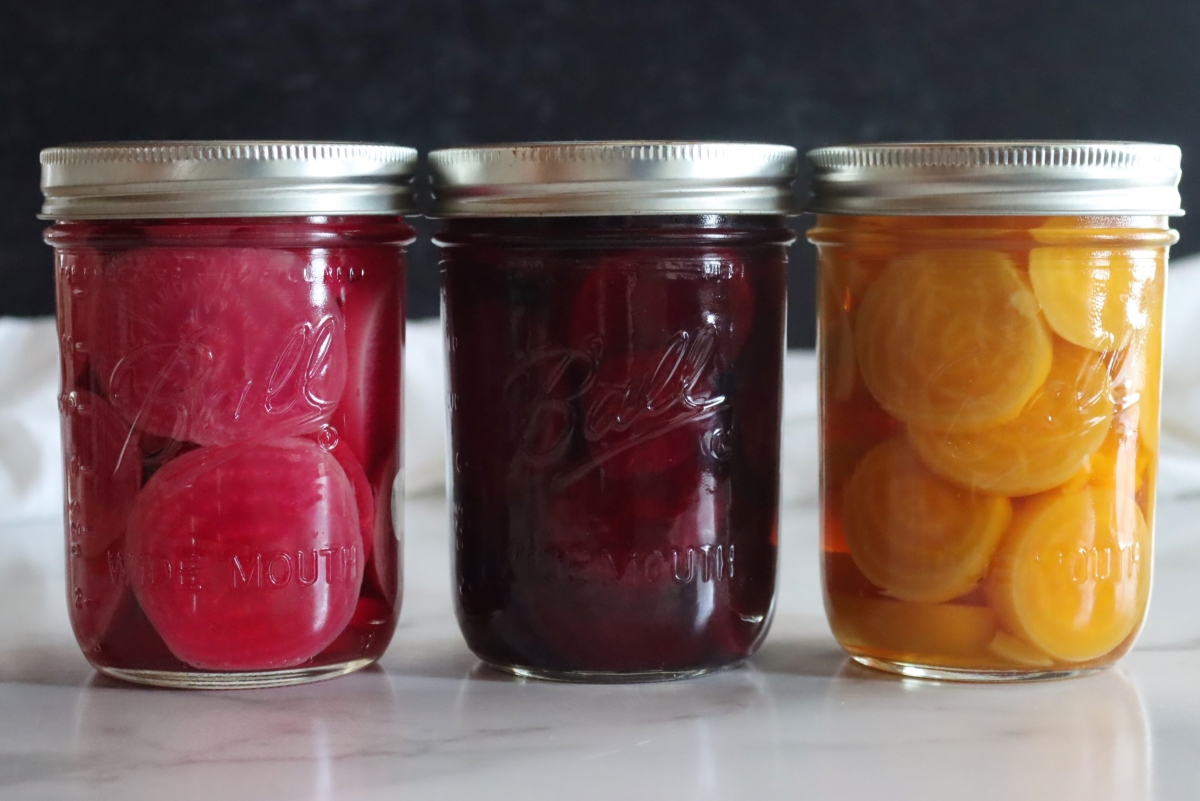
We put up hundreds of jars of home-canned good each year, including all manner of jam, jelly, pickles, fruits, veggies, and soups. A full basement and lots to choose from, but would you believe that pickled beets are my absolute favorite wintertime condiment?
Beets have a natural earthy sweetness that plays beautifully against the acidic brine, creating a well-rounded flavor that’s good with almost anything. I serve pickled beets alongside hearty breakfasts, forking them up in the same bite with rich hash browns.
The tangy flavor from the pickled beets creates the perfect foil for rich heavy winter fare, and the warm spices bring life to the dish.
These days I make several different varieties of pickled beets, so I have plenty of choices on hand no matter what’s for dinner.
Pickled golden beets made with cider vinegar have a nice clean flavor (and won’t stain your shirt). I also make balsamic pickled beets, with just a sprinkle of salt, and they’re perfect for tossing with feta and red onions for a quick salad.
Really, the sky’s the limit, provided you follow a few simple rules to ensure safe pickling (whether you’re canning or making refrigerator pickles).
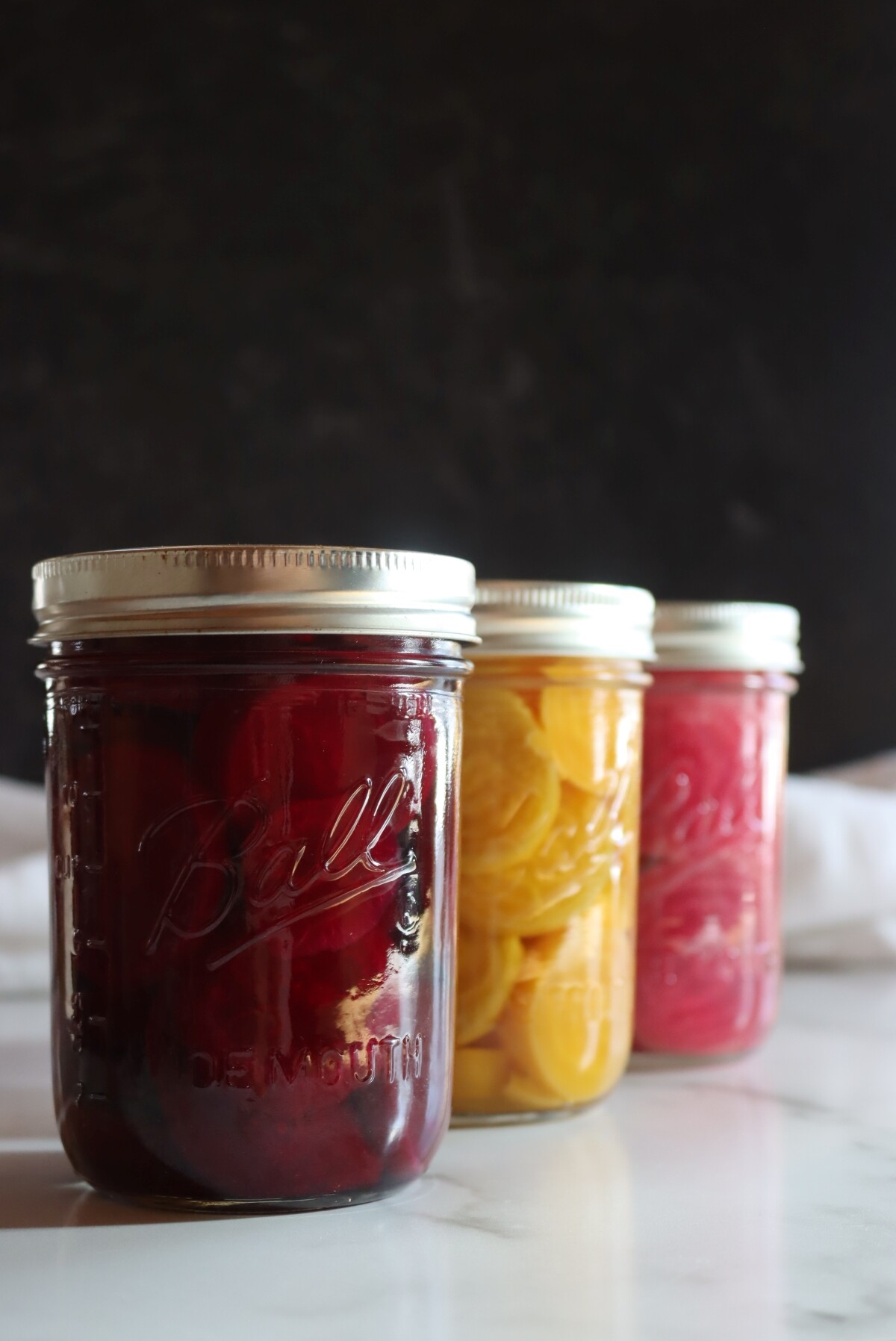
Best Beet Varieties for Pickling
Believe it or not, some beets are better for pickling than others.
Smaller, early season beets are bred to be tender, sweet, and uniform, which makes them perfect for pickling. They don’t store well in a root cellar on their own, especially compared to late-season storage beets, but it doesn’t really matter since they’ll store perfectly fine as pickled beets.
Large beets and late-season beets can be tough and woody, and you’ll notice the difference in your pickled beets. Really, if you’re canning pickled beets as a method of preservation, you should be doing it mid-summer with the early crop (rather than with the long-season crop in the fall).
If you’re buying beets for pickling, choose smaller beets that are as uniformly round as possible. When they start getting big and warty, the internal structure is less tender. Ideally, pick those bunches of beets with the tops attached, as that shows that they’re fresh short-season beets (rather than long-season storage beets, which die back at the top at maturity).
The beets below were harvested young and a bit smaller than full-sized storage beets, which is perfect for making pickled beets.
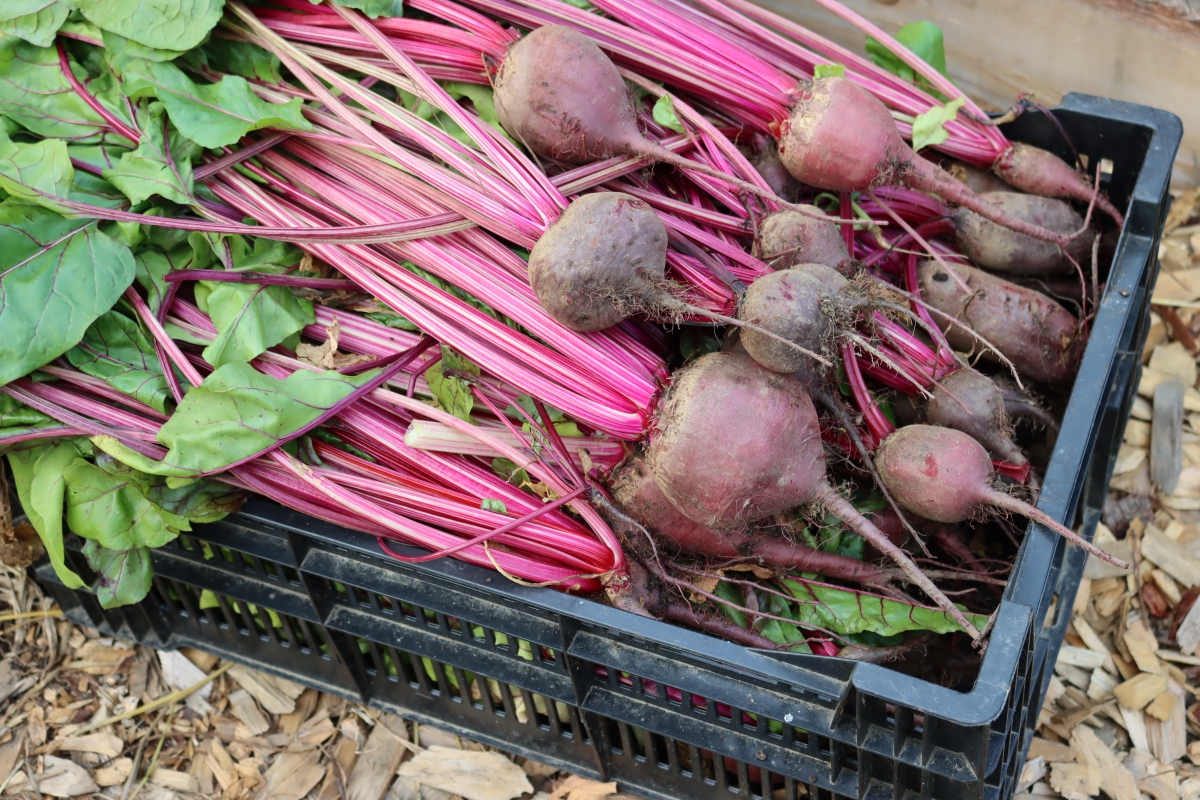
Pickling Golden or Striped Beets
The color of a beet isn’t just cosmetic, it really affects the flavor!
Golden beets have a clean, sweet flavor that lacks the “earth-y” taste I associate with red beets. They really have their own flavor, and I absolutely love it though it’s unique and not what you’d generally associate with the flavor of grandma’s pickled beets. Still be sure to choose smaller, early season beets as golden beets can get tough in storage too.
There’s something in that red pigment that gives them a different flavor, and if you want that classic old school pickled beet flavor go with the deepest red beet you can find. Growing your own, try “tall top early wonder” (a tender early-season beet with deep red color) or “bulls blood” which is deep red as the name suggests.
I don’t recommend pickling striped or pink beets for a few reasons.
First, they just don’t taste as good. They lack the fresh unique flavor of golden beets, and they don’t have the rich beet-y flavor that comes with a deep red beet. They’re beautiful on a salad, but they just come out bland and disappointing when cooked.
Second, they won’t look nearly as good in the jar. The “pink” beets below are actually striped beets, and the color bleeds into a uniform pink during cooking. They’ll look nice enough right after you make them, with nice pink color, but over time they’ll fade to near white as the brine robs them of what’s left of their color.
You’ll end up with bland tasting white beets in a pink brine, instead of pretty striped or pink pickled beets.
Stick with deep red or gold varieties if you want the very best pickled beets.
(If all you have is pink or striped beets, just plan to eat them sooner for the best flavor. If I get some in a CSA box, I’ll make quick pickled beets for salads.)
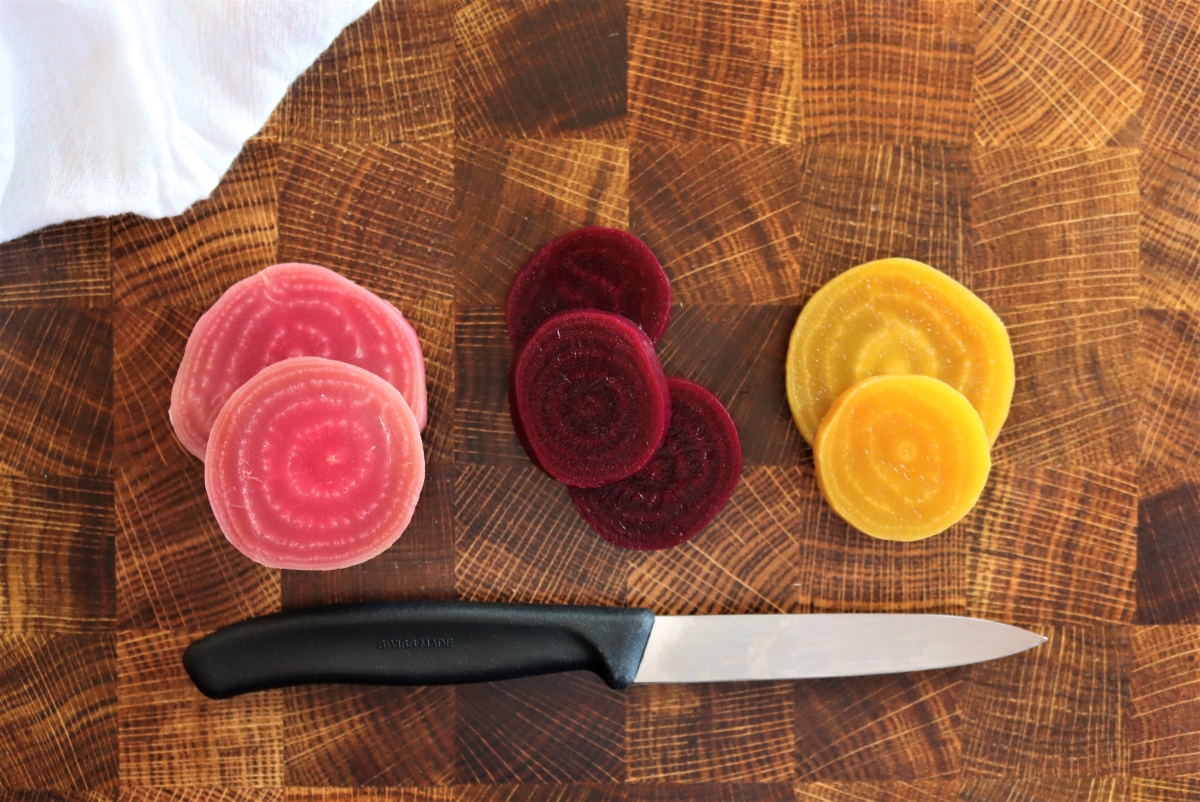
Spices for Pickled Beets
This is largely a matter of personal taste, and honestly, it’s completely up to you.
“Classic” pickled beets usually have warm spices, including cloves, allspice, and cinnamon. It plays really well against their natural flavors, and since they’re traditionally eaten alongside wintertime meals it goes well with the other flavors served at that time.
Summertime pickles, like bread and butter pickles and classic dill pickles, are made with fresh flavors that play well against warm-season meals.
That said, there’s no reason you can’t season your pickled beets any way you’d like.
Preservation and “pickling” comes from the vinegar, not the spices, and you can use the spices from just about any pickle recipe for pickled beets. You can even go really unconventional if it suits your fancy. Try these ideas:
- Thai spice pickled beets with Thai basil, red chili, ginger, and lemongrass.
- Curry pickled golden beets with curry, black pepper, and cardamom.
- Tarragon pickled beets with red onion, tarragon, and thyme.
That said, I prefer old-fashioned pickled beets made with a slice of onion, cinnamon, cloves, and allspice. I cook the cinnamon sticks for a short while along with the brine, then remove them as they can get bitter if left in the jar. The rest of the spices go right into each jar after I’ve packed the beets but before I’ve poured in the hot brine.
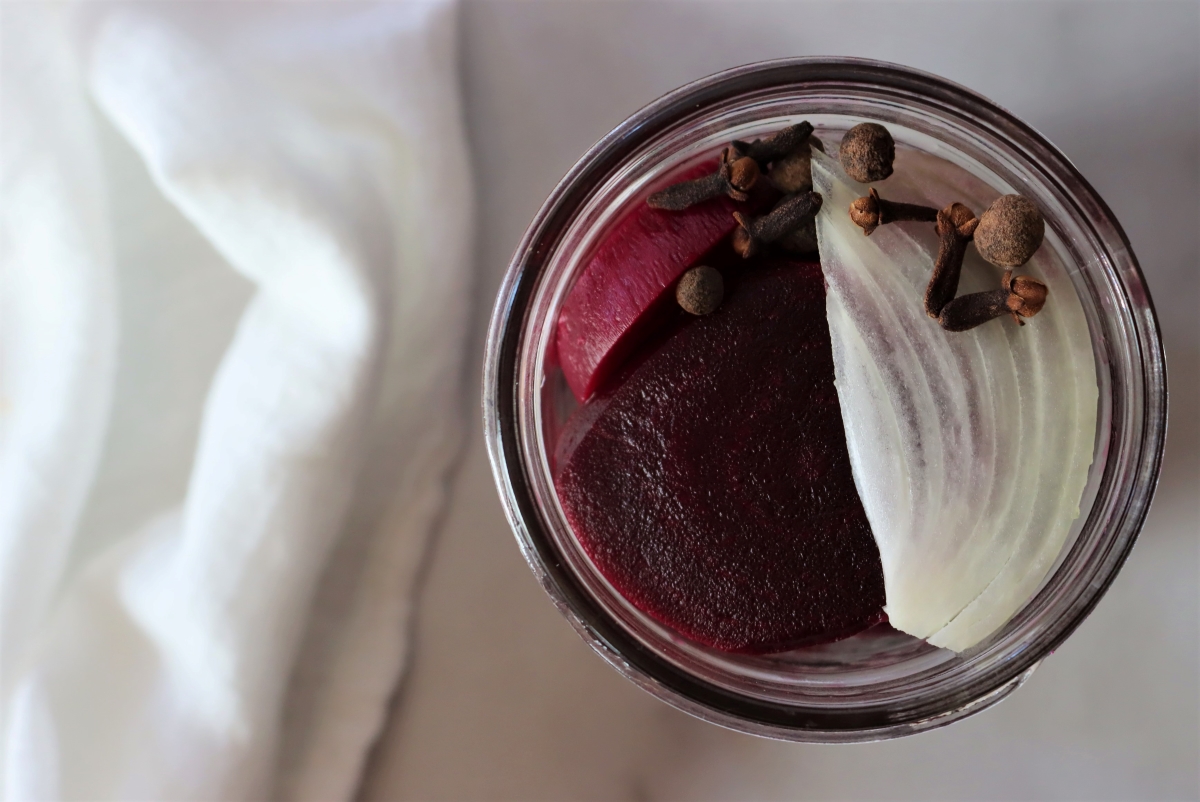
Brine for Pickled Beets
So while the spices are pretty flexible, the brine is used for preservation and has some important guidelines.
Believe it or not, salt isn’t really the dominant preservation agent here and you can actually leave it out altogether if you choose (though I wouldn’t recommend it). Sugar as well, is just there for flavor, bringing out the natural sweetness of the beets, rather than for preservation.
The vinegar is the important part, and the only thing that’s absolutely vital about making pickled beets safely. The brine must be at least 50% vinegar, and that vinegar must be at least 5% acidity.
Check the bottle, just about all vinegar bottles will list the acidity percentage, and you’d be surprised how much they can vary.
Rice vinegar, for example, is often milder and only 4% acidity. Some jugs of “canning vinegar” are pre-diluted with 50% water so that you can use them directly, but that means they’re way below 5% acidity and can’t be used in regular pickle recipes.
While you can use any type of vinegar that suits your taste, including malt vinegar, balsamic, apple cider, rice vinegar or just plain white vinegar, be sure you check the label for acidity percentage first.
Old fashioned pickled beets generally use white vinegar or apple cider vinegar, and usually use a bit more than 50%. Most pickled beet recipes opt for 2 parts vinegar and 1 part water, though some extra tangy pickled beets use all vinegar and then add a good bit of sugar to balance the flavor.
For my basic brine, I use 2 parts vinegar, 1 part water, 1 part sugar, and just a bit of salt. Feel free to reduce the sugar, but note that these are supposed to be a sweet pickle, so I’d still go with at least 1/2 to 1 cup per batch.
A 4-pint batch uses this basic pickling brine:
- 2 cups Vinegar
- 1 cup Water
- 1 cup Sugar
- 1 tsp. Salt
I simmer this brine with 1-2 cinnamon sticks for about 5 minutes, then remove the cinnamon. To each jar, I add the beets, a slice of onion, and a few cloves and allspice berries before pouring the brine over the beets.
(You can also substitute wine, grape juice, or apple juice in place of the water for a unique flavor.)
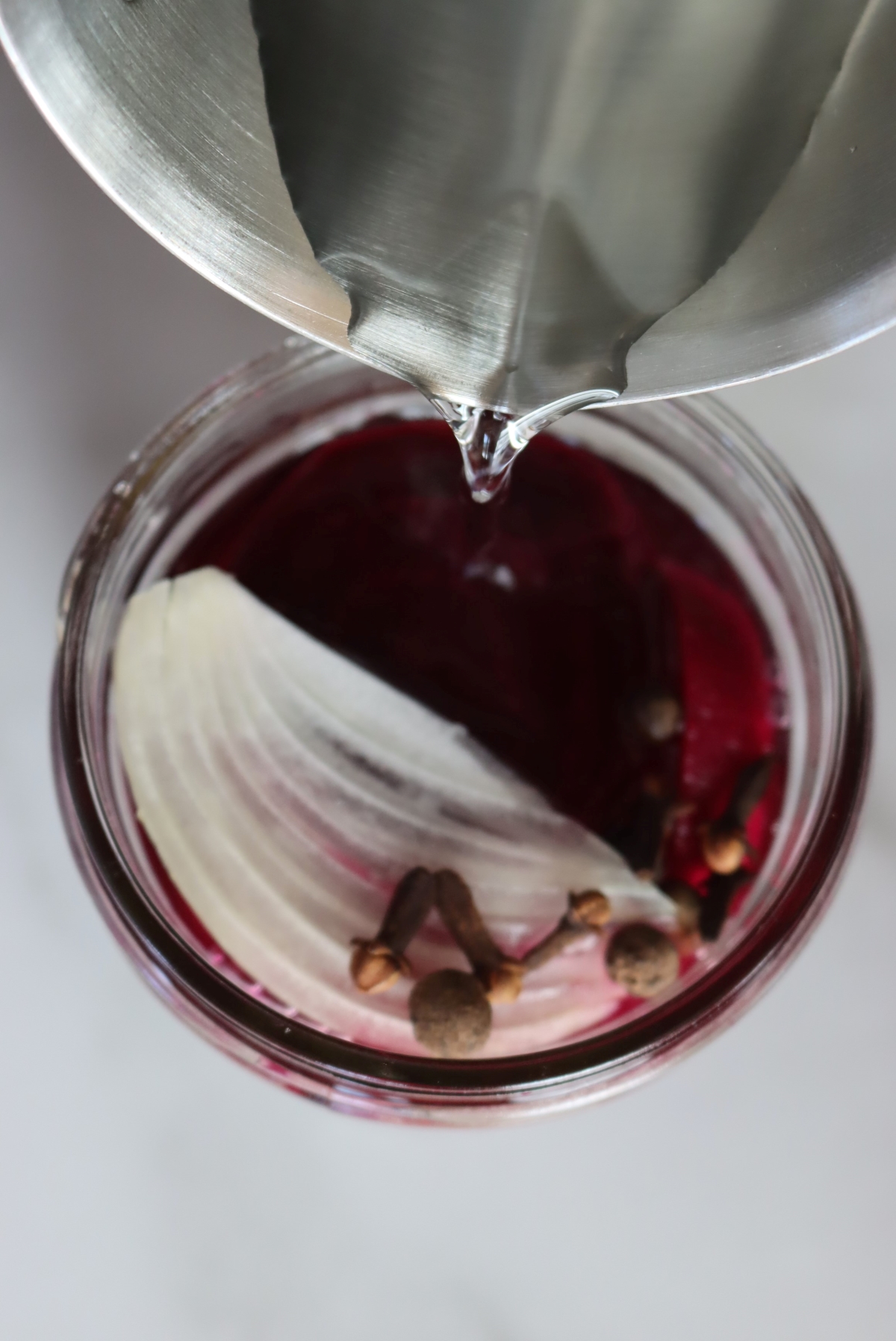
How to Make Pickled Beets
Making pickled beets starts with preparing the beets.
Start a stockpot of water boiling on the stove and add the beets. At this point, they should still have their roots and about 1 inch of tops attached. Cutting those off first causes the beets to bleed more during cooking, and they’ll lose both color and flavor to the initial cooking water.
Small beets take about 20 to 25 minutes to cook through, but larger beets can take considerably longer. Test the beets with a fork, they should be tender to the center when you take them off the heat.
Allow the beets to cool, then remove the tops and roots with a sharp knife. Use your fingers to slip the beet skins off the outside of each beet. The skins don’t taste nearly as good as the rest of the beet, so this is important. If they’re properly cooked through, they should rub off easily with a bit of pressure from your thumb.
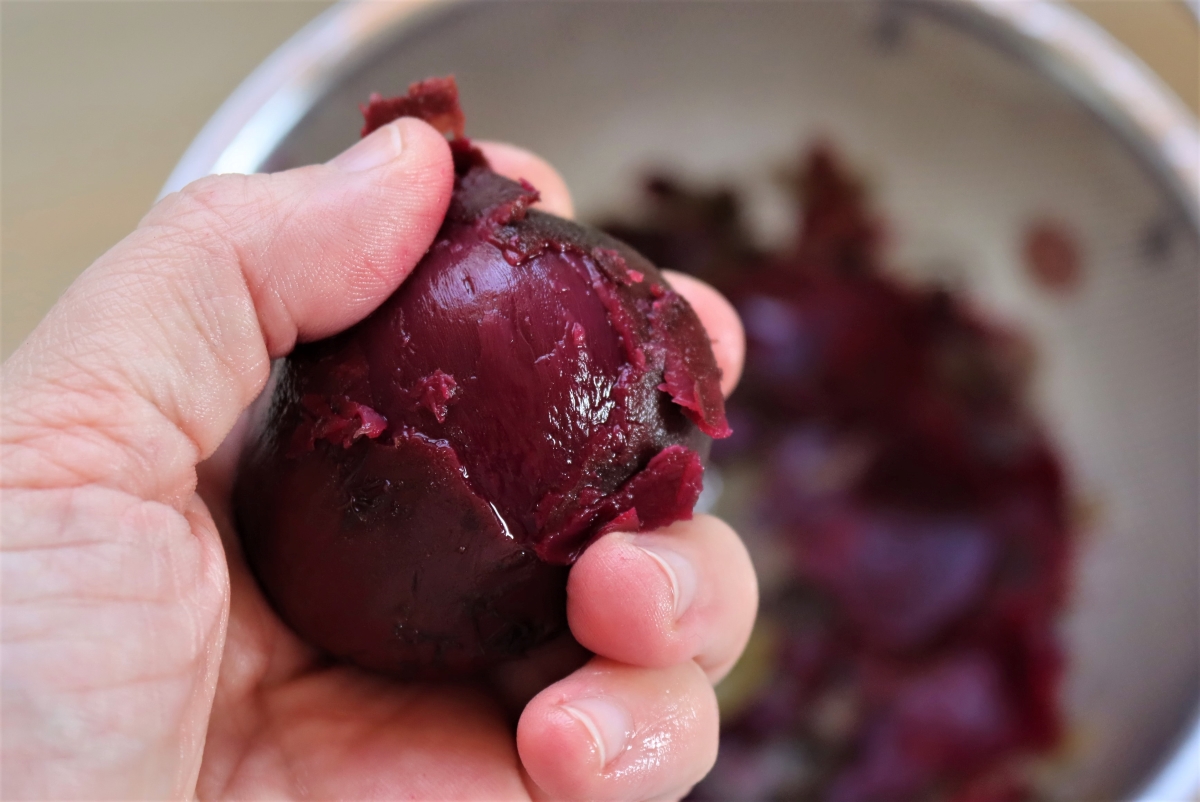
Slice the beets, or leave them whole if they’re really small.
At this point, you have the choice between hot pack and cold pack. Personally, I opt to cold pack the beets since it’s a lot easier to get them into the jars when they’re cool rather than boiling hot.
For cold pack, simply load the jars with the beet slices, along with any onion, garlic or spices. Be sure to leave 1/2 inch headspace at the top of the jars. Bring the brine to a boil on the stove and pour it over the top of the beets, maintaining a 1/2 inch headspace. If canning, ensure that your canner water is at around 140 degrees F when the jars go in to avoid thermal shocking the jars. Don’t begin the canning timer until the water is at a full rolling boil.
For hot pack, bring the brine to a hard boil on the stove and add the beets. Boil hard for 5 minutes, until the beet slices are hot all the way through. Pack into jars while hot, leaving 1/2 inch headspace. If canning, the canner should be at a simmer (180 degrees F) when the jars go in for a hot pack. Start the timer when the canner comes up to a rolling boil.
For refrigerator pickles, definitely do cold pack and just pour a hot brine over the cooked (but cooled) beet slices. Allow the jars to cool to room temperature before storing in the refrigerator.
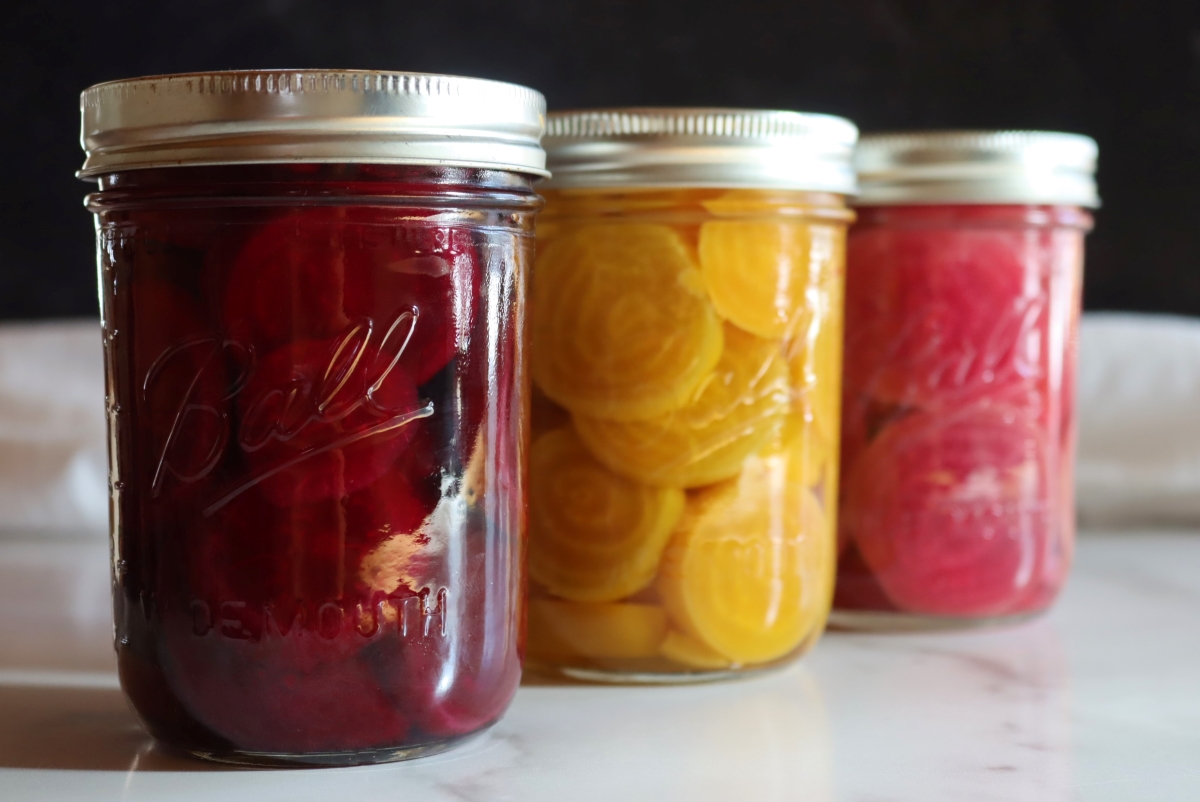
Canning Pickled Beets
It’s perfectly fine to make quick pickled beets, which are stored in the refrigerator. They’ll be ready to eat in a few days, and then last about a month.
Personally, I’m canning pickled beets in the summer months when the tender early season beets come in, and then I’m usually eating them in the cold winter months. For that reason, I always can pickled beets rather than make a quick pickle.
(If you’re not familiar with water bath canning, please read this beginner’s guide to water bath canning before proceeding.)
If canning, pack as directed above, paying special attention to the temperature of the water in the canner. For a cold pack, the water should be very hot, but nowhere near boiling (around 140 degrees F). For a hot pack where the beets have been boiled in the brine, the canner should be simmering at 180 degrees F. This doesn’t have to be exact, but matching the canner temperature somewhat to the jar temperature helps prevent broken jars as a result of thermal shock.
Load the jars in with a canning jar lifter and then bring the water bath canner up to a full rolling boil. Once boiling, start the timer and process the jars for 30 minutes (below 1,000 feet in elevation). For higher elevations, refer to the table below:

Pickled beets are normally canned in either pints or quarts, and the canning time is the same for both jar sizes. They cannot be canned in larger jars, so no half gallons. They can, however, be canned in smaller jars including half pints and even quarter pints, still using the same canning time.
Pickled Beet Recipe Variations
My favorite pickled beet recipe is very similar to the classic recipe listed in the Ball Complete Book of Home Preserving. They use slightly more vinegar, and they also choose to use store-bought “pickling spice” instead of my warm spice blend.
They offer a few variations on their basic recipe, suggesting:
- Caraway Pickled Beets – Substitute 2 tbsp caraway seeds and 2 tsp black peppercorns for the other spices.
- Pickled Beets and Onions – Use only 3 lbs beets (instead of 4), and add 3 cups sliced onions.
This basic pickled beet recipe is incredibly popular, and it’s is also basically the same in a number of canning books including The Complete Book of Small-Batch Preserving, Mrs. Wages Home Canning Guide and Recipes, The Beginners Guide to Canning, and Marion Brown’s Pickles and Preserves.
Those are some pretty minor variations, but there are a few pickled beet variations out there:
- Food In Jars: Preserving in Small Batches Year-Round – She suggests using an all cider vinegar brine (no water), doubling the sugar to balance the extra vinegar tang, and seasoning with a cinnamon stick and a chunk of ginger simmered in the brine together (no spices in the jars).
- Preserve It! – Also suggests using an all vinegar brine with no water, but they choose red wine vinegar. They don’t increase the sugar to balance, so the finished pickled beets will be quite sour. They spice with star anise, bay leaves, black pepper, and cinnamon.
- Canning For a New Generation – Sweetens the pickled beets with honey instead of sugar, but otherwise has a similar recipe to mine.
Beyond Pickled beets, you can also try Beetroot Relish, Beetroot Chutney, or Beetroot Ketchup. All three also mix sweet/sour flavors with the use of sugar and vinegar, but the slicing and spice mix is much different.
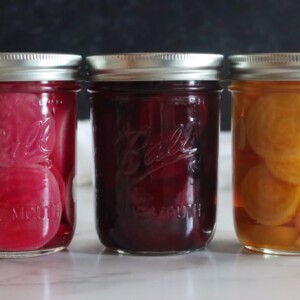
Pickled Beets
Ingredients
- 4 lbs Beets, 2 to 2 1/2 inch Diameter
- 2 cups Vinegar, White or Apple Cider
- 1 cup water
- 1 cup sugar
- 1 tsp salt
- 1 cinnamon stick
- 12 to 16 cloves 3-4 per pint
- 12 to 16 allspice berries, 3-4 per pint
- 1/4 to 1/2 onion, sliced
Instructions
- Prepare beets by boiling until tender, roughly 20 to 25 minutes for small beets.
- Strain beets (discarding liquid) and allow them to cool. Cut off tops and roots, then peel with finger pressure.
- Slice beets (or leave whole) and pack into pint jars. Add 3-4 cloves and allspice berries to each jar, along with a slice or two of onion.
- If canning, prepare a water bath canner by warming the water to roughly 140 degrees F. (This is a cold pack recipe, for hot pack see notes.)
- In a clean pot, add vinegar, water, sugar, salt, and a cinnamon stick. Bring the mixture to a boil and simmer 5 minutes, stirring to dissolve the sugar. Remove from heat and discard the cinnamon stick.
- Pour the brine over the beets in the jars, maintaining a 1/2 inch headspace. Cap with 2 part lids, tightening to finger tight.
- If canning, process the pickled beets for 30 minutes (under 1000 feet in elevation), starting the timer once the canner has reached a full rolling boil. See notes for altitude adjustments.
- For refrigerator pickled beets, skip the canning step and simply allow the jars to cool to room temperature on a towel on the counter before storing in the refrigerator.
Refrigerator pickled beets will keep roughy 3-4 weeks in the refrigerator. Properly water bath canned pickled beets will maintain quality on the pantry shelf without refrigeration for 12 to 18 months if sealed. Store in the refrigerator once opened.
Notes
- 1,001 to 3,000 Feet Process for 35 Minutes
- 3,001 to 6,000 Feet Process for 40 Minutes
- Above 6,001 Feet Process for 45 Minutes
Easy Pickle Recipes
Making more than just pickled beets this season?
Water Bath Canning Recipes
Looking for more easy water bath canning recipes to put up the harvest?
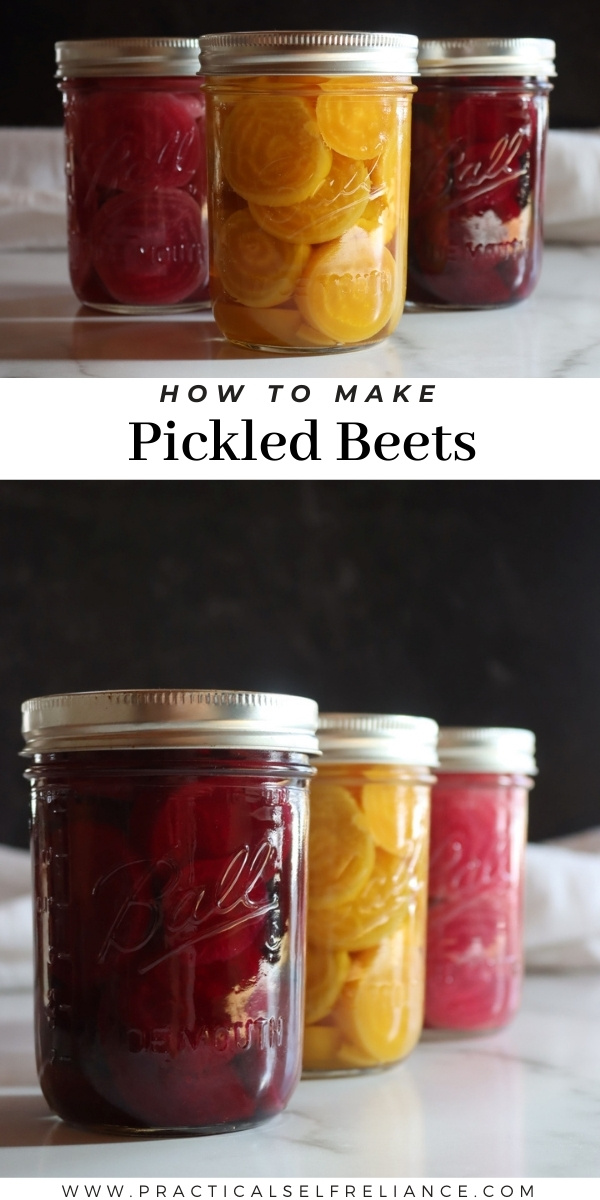
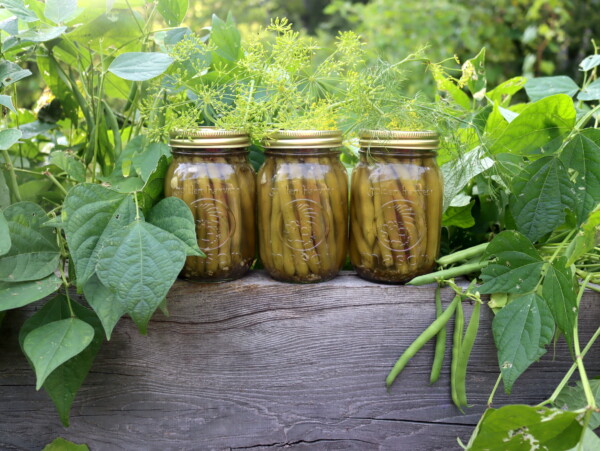
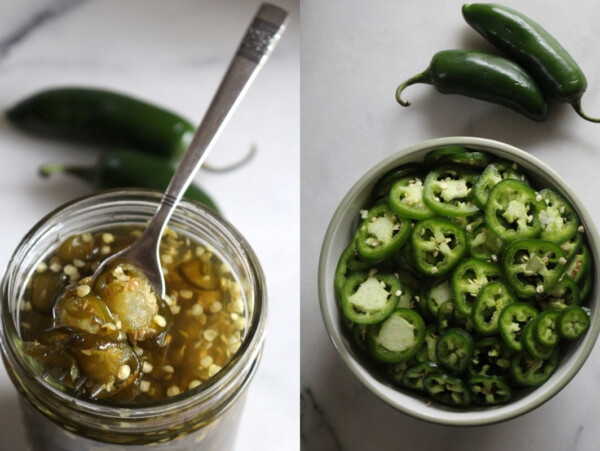
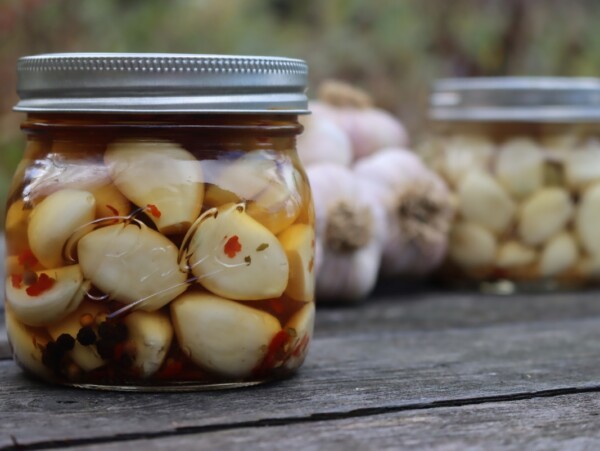
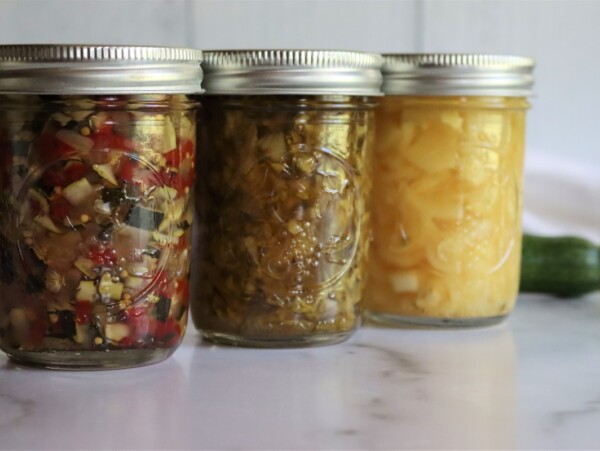
Great article and links! Thank you so much!
Hello Ashley.
I have never rated recipes I have used in the past but after finding your recipes on Pinterest and now your website, I always look for your recipes when canning. Today, our first recipe we made are your pickled beets (I used a sweet red Moscato wine for the water and I didn’t have any allspice – sorry I can’t ever follow a recipe exactly as written). We are on round 2 in the water bath; however, I might not be able to finish canning all of them as our daughter keeps eating them!
Currently in the crockpot, I used your Maple Whiskey Pear Jam recipe; however, again I used the sweet red Moscato wine with honey (we don’t have any maple syrup or whiskey in the house). They smell absolutely wonderful, and I can’t wait to get these canned.
When I read your full bio, I noticed you mentioned cheesemaking. Having graduated in culinary and bakery (for fun), I will see what recipes you are sharing and try some in the near future. I found your recipe on cultured butter and hope to make that soon as well. I am also growing / using herbs for medicinal purposes. I have made salves for skin issues in the past but look forward to trying your recipes as well.
Having just retired last year after living the corporate life, we have started with an expanded garden this year. We look forward to seeing how our harvest goes and what recipes you offer for our bounty. Thank you so very much for sharing your expertise and experience to help others. It is so very much appreciated.
Wow, thank you so much Kim! You really made my night and I’m so glad you’re enjoying my recipes. Cheesemaking is so much fun, and it’s a whole different level of satisfying to pull out a homemade cheese for your family. (But then, of course, once you get into that, you’ll start salt curing meat…it’s kind of a gateway hobby…just like canning.)
I spent as much time as I could handle in corporate life before this life, and the transition really is crazy. I hope you enjoy all your newfound time to play in the kitchen and the garden. It never gets old!
I’m so happy to have you here and enjoying so many recipes. Have you seen my newsletter? I send out updates a couple of times a month with what we’re up to here and new recipes: https://ashleyadamant.substack.com/
Hope to have you along, and nice to meet you Kim!
I like to “roast “ my beets wrapped in foil in the crockpot for a few hours. This keeps vitamins in the beets and also allows me to do other things while cooking. Plus my kitchen stays cooler.
Penny
Sparks NV
I’m always asked to bring my pickled beets to parties. My problem is the spices that stick to the beets, causing folks to have to pick them out. (Nobody wants to bite into a whole clove or allspice.) I’m wondering if it would be safe to leave a metal spice ball or cheesecloth sit in the recipe for several days?? I like to make my beet recipe a few days in advance and keep them in the fridge… each day the spices enhance the flavor. But I’m trying to find a solution to removing those little spices before putting them in a serving bowl. A spice ball or cheesecloth is the only thing I can think of??? Just don’t know if it’s safe to leave sitting in the beets for days…any help would be appreciated.
I would not use anything metal with the vinegar but you could do some cheesecloth without any issues.
Hey, wondering can you use powdered cloves and allspice if you don’t have whole?
Yes, you could, though it will look like dirt in the jar. That’s a cosmetic thing, so not really an issue. Ground spices have a lot more surface area, so you’ll want to use WAY less. For cloves especially. Literally just the tiniest pinch per jar.
I want to thank you for sharing your home recipes , they are right on and I have tried many .
i JUST DISCOVERED YOUR SITE AND i LOVE HOW YOU WRITE – so clear and straightforward.
My mom was British so I grew up on beets: pickled, canned, fresh, boiled, baked, I’m looking forward now to every post!
Thank you so much. I am so glad that you are enjoying the posts!
I’m growing golden beets for the first time this year & am very excited to try them. I have never even eaten them before, so hopefully I like them! Have you ever pickled the golden beets together with red ones in a mix?
I have been growing Cylindria beet which is a long variety that’s super dark in color. Chioggia striped beets are neat to look at, but I usually pickle them with a mix of dark red beets. So the brine ends up a much darker reddish color. I’ve never pickled the striped varieties alone before, so I didn’t know they’d be more bland.
You could certainly pickle the golden beets and red beets together but then you would miss out on that beautiful golden color.
Great article! Makes me hungry just looking at the pictures. You never did say just exactly what you do with the larger more mature beets. You pickle the small ones but, you can’t possibly eat all of the large ones before they go bad. Gifts perhaps! What type of onion do you prefer to use with the beets? Spanish,sweet?
Hope you are keeping warm! Thanks…
Large ones store for months in the refrigerator believe it or not. If you don’t have storage space though, I’d recommend just harvesting everything on the small/tender side and then making both this recipe for pickled beets and canning plain beets (pressure canner). Anytime you’re canning beets, the quality will be better if they’re the smaller and more tender beets, as they tend to be tough/stringy if you can the really monster sized ones.